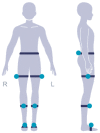Lasso Analysis of Gait Characteristics and Correlation with Spinopelvic Parameters in Patients with Degenerative Lumbar Scoliosis
- PMID: 38003891
- PMCID: PMC10671873
- DOI: 10.3390/jpm13111576
Lasso Analysis of Gait Characteristics and Correlation with Spinopelvic Parameters in Patients with Degenerative Lumbar Scoliosis
Abstract
Purpose: This study quantifies the gait characteristics of patients with degenerative lumbar scoliosis (DLS) and patients with simple lumbar spinal stenosis (LSS) by means of a three-dimensional gait analysis system, aiming to determine the image of spinal deformity on gait and the correlation between spinal-pelvic parameters and gait characteristics in patients with DLS to assist clinical work.
Methods: From June 2020 to December 2021, a total of 50 subjects were enrolled in this study, of whom 20 patients with DLS served as the case group and 30 middle-aged and elderly patients with LSS were selected as the control group according to the general conditions (sex, age, and BMI) of the case group. Spinal-pelvic parameters were measured by full-length frontal and lateral spine films one week before surgery, and kinematics were recorded on the same day using a gait analysis system.
Results: Compared to the control group, DLS patients exhibited significantly reduced velocity and cadence; gait variability and symmetry of both lower limbs were notably better in the LSS group than in the DLS group; joint ROM (range of motion) across multiple dimensions was also lower in the DLS group; and correlation analysis revealed that patients with a larger Cobb angle, T1PA, and higher CSVA tended to walk more slowly, and those with a larger PI, PT, and LL usually had smaller stride lengths. The greater the PI-SS mismatch, the longer the patient stayed in the support phase. Furthermore, a larger Cobb angle correlated with worse coronal hip mobility.
Conclusions: DLS patients demonstrate distinctive gait abnormalities and reduced hip mobility compared to LSS patients. Significant correlations between crucial spinopelvic parameters and these gait changes underline their potential influence on gait disturbances in DLS. Our study identifies a Cobb angle cut-off of 16.1 as a key predictor for gait abnormalities. These insights can guide personalized treatment and intervention strategies, ultimately improving the quality of life for DLS patients.
Keywords: Cobb angle; balance; degenerative lumbar scoliosis; gait; lumbar stenosis syndrome.
Conflict of interest statement
The authors declare no conflict of interest. The funders had no role in the design of the study; in the collection, analyses, or interpretation of data; in the writing of the manuscript; or in the decision to publish the results.
Figures



Similar articles
-
Mid-term changes in spinopelvic sagittal alignment in lumbar spinal stenosis with coexisting degenerative spondylolisthesis or scoliosis after minimally invasive lumbar decompression surgery: minimum five-year follow-up.Spine J. 2022 May;22(5):819-826. doi: 10.1016/j.spinee.2021.11.012. Epub 2021 Nov 20. Spine J. 2022. PMID: 34813957
-
The Correlation of Spinopelvic Parameters With Biomechanical Parameters Measured by Gait and Balance Analyses in Patients With Adult Degenerative Scoliosis.Clin Spine Surg. 2020 Feb;33(1):E33-E39. doi: 10.1097/BSD.0000000000000939. Clin Spine Surg. 2020. PMID: 31996610
-
Compensatory Mechanism of Maintaining the Sagittal Balance in Degenerative Lumbar Scoliosis Patients with Different Pelvic Incidence.Orthop Surg. 2020 Dec;12(6):1685-1692. doi: 10.1111/os.12805. Epub 2020 Sep 21. Orthop Surg. 2020. PMID: 32954650 Free PMC article.
-
Minimally invasive decompression surgery for lumbar spinal stenosis with degenerative scoliosis: Predictive factors of radiographic and clinical outcomes.J Orthop Sci. 2017 May;22(3):377-383. doi: 10.1016/j.jos.2016.12.022. Epub 2017 Feb 1. J Orthop Sci. 2017. PMID: 28161236 Clinical Trial.
-
Gait analysis using digital biomarkers including smart shoes in lumbar spinal canal stenosis: a scoping review.Front Med (Lausanne). 2023 Dec 14;10:1302136. doi: 10.3389/fmed.2023.1302136. eCollection 2023. Front Med (Lausanne). 2023. PMID: 38162877 Free PMC article.
References
-
- Abdel-Fattah A.-R., Bell F., Boden L., Ferry J., McCormick C., Ross M., Cameron I., Smith T., Baliga S., Myint P. 327 To Fuse or Not to Fuse: The Elderly Patient with Lumbar Stenosis and Low-Grade Spondylolisthesis. Systematic Review and Meta-Analysis of Randomised Controlled Trials. Br. J. Surg. 2022;109((Suppl. S6)):znac268.003. doi: 10.1093/bjs/znac268.003. - DOI - PubMed
LinkOut - more resources
Full Text Sources
Research Materials
Miscellaneous

